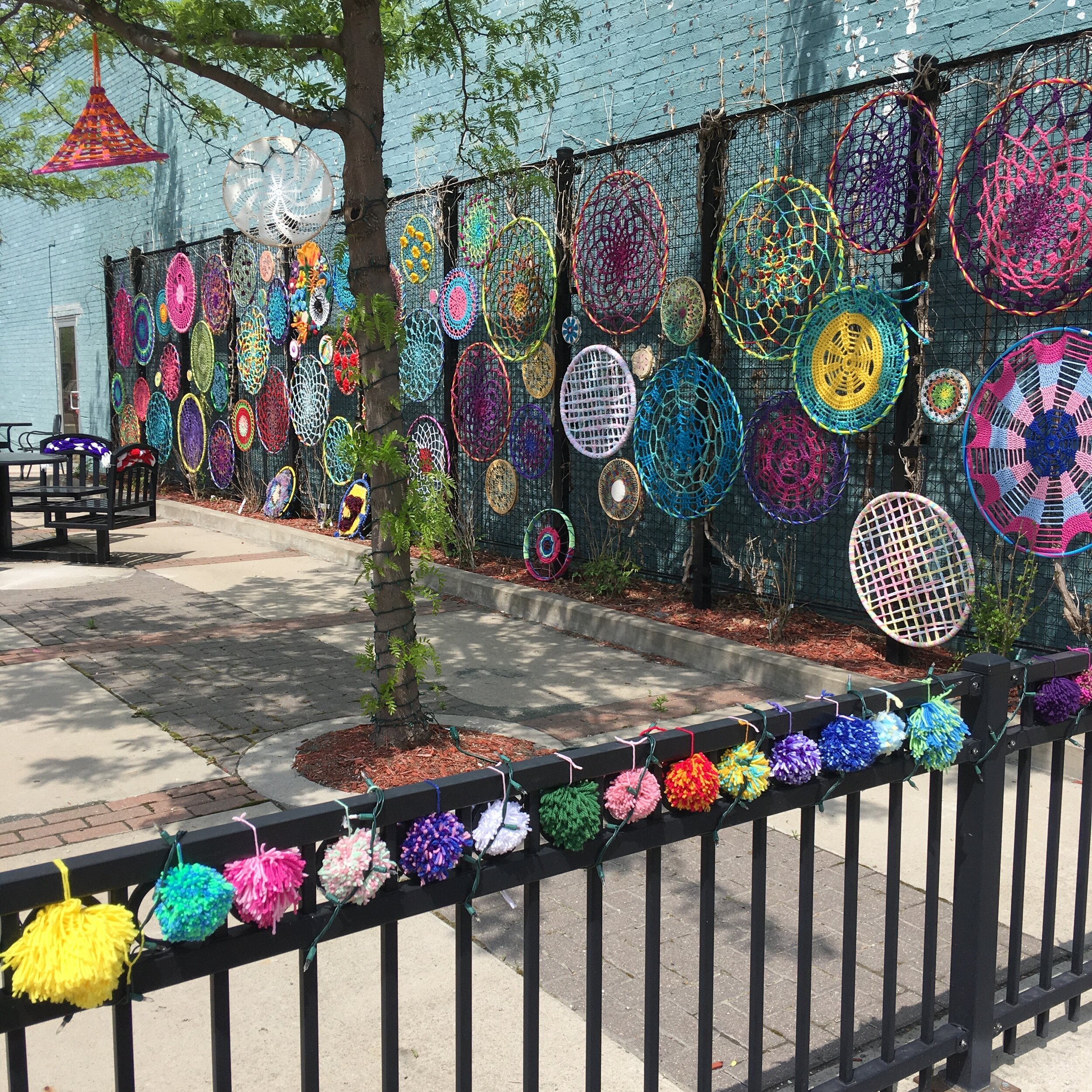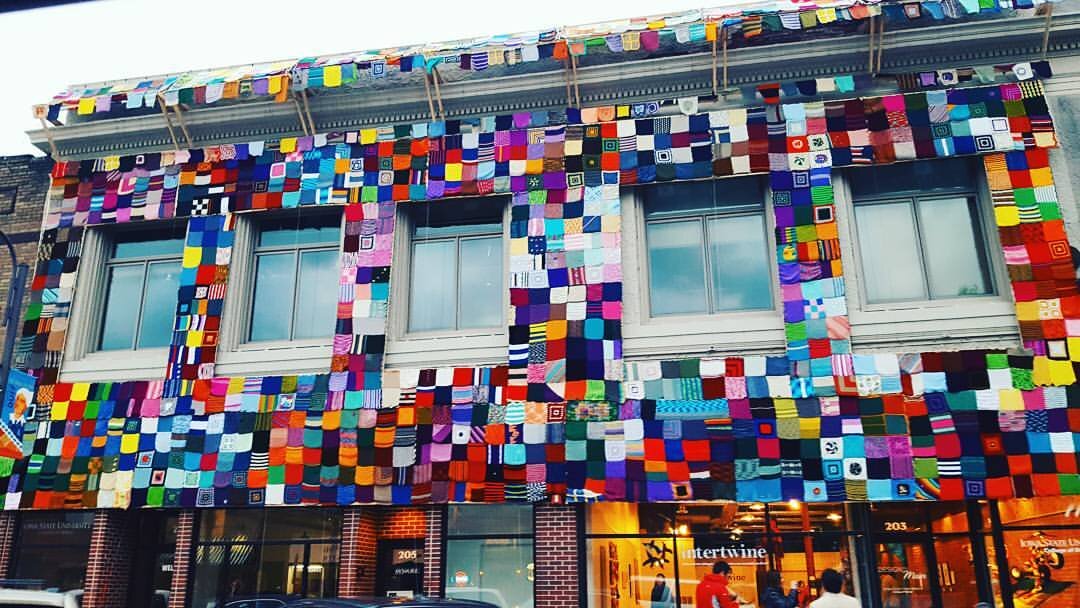Yarn Bomb! A Toolkit for Community Fiber Projects
Installation complete! Intertwine, Ames, Iowa.
In 2015-16, I organized and coordinated Intertwine, a collaborative, large-scale yarn-bombing project on the two-story façade of ISU Design on Main community gallery (RIP Design on Main) in the Main Street Cultural District in Ames, Iowa. In a nutshell, the project involved covering the building with 1200+ 1’ x 1’ squares created by over 150 makers from 14 states and dozens of Iowa communities. Folks organized formal and informal knitting get-togethers for Intertwine across Iowa, and in Mississippi, Tennessee, and New Orleans. Participants ranged in age from 9 to 93 years old, and, while mostly women, came from a variety of professional backgrounds, from retiree to student to artist to IT consultant. The final installation was pretty spectacular. After we took Intertwine down, we had each square dry-cleaned and then transformed them all into over 40 blankets to be donated to the Achieving Maximum Potential Program at the Youth and Shelter Services here in Ames.
Why a Yarn Bomb?
I should mention here that I neither knit nor crochet. I’m super comfortable in front of an easel or with an embroidery project, but hand me some knitting needles and I get downright sweaty. So why would I decide to organize a giant yarn-bomb project?
My impetus for this project was twofold: 1) Create ways for broad community participation in a large-scale public art project and 2) See if and how community relationships could be built in the process.
Okay, yeah, and so why knitting? Four reasons.
Historically, quilting and knitting circles have been opportunities where women could freely gather in community to make, mend, and talk. Stitching can be social. (Just ask Catherine Reinhart about her Collective Mending Sessions project.)
Many people who knit may not consider themselves to be artists, and yet may not be intimidated by being involved in a large knitting project versus another public art form. I believe that yarn is more accessible than, say, paint or ceramics or metal.
I could include folks who weren’t local to Ames in the project.
A final consideration was that as a painter with no knitting experience, I had to rely on the knowledge and expertise of others. Working with unfamiliar processes forced me to create strong community partnerships and to create authentic opportunities for other artist leaders in the project.
The first panel is installed = relief and joy. Intertwine, Ames, Iowa.
Artist Leaders
Kristin M. Roach, an Ames fiber artist, entrepreneur, and all-around badass (and an artist in the For the Common Good Community Artist Interview Series), acted as an artist consultant for Intertwine and was paid a stipend for her leadership in this project. (Lesson 1. Pay your artists!) Kristin created an Intertwine zine, a homemade, self-published magazine that was a free resource and guide for Intertwine. Kristin’s zine enabled community members to learn knitting and crocheting step-by-step, as well as learn the history of the project, dates of all upcoming events and workshops, and multiple resources for knitting and crocheting. Free copies were available at Design on Main and to non-local participants. Kristin also taught knitting and crocheting workshops at ISU Design on Main, and assisted participants during the knitting circles.
Building Community
ISU Design on Main hosted free knitting and crocheting classes and twelve public knitting circles every other week throughout the project. Many times, the same people would attend these events, creating a sense of community and camaraderie during the year, while encouraging participants to teach and learn skills from one another.
I partnered with a local brewery, pub, and wine bar to host six “Block Parties” in the months leading up to the installation. Knitting in different and unexpected venues introduced new audiences to the project, as well as introduced the knitters to these cool, local businesses. All events were free and open to the public.
Intertwine Block Party, Alluvial Brewery, Ames, Iowa.
Yarn Bomb! A Toolkit for Community Fiber Projects
I released Yarn Bomb! A Toolkit for Community Fiber Projects, a brand-new toolkit that anyone can download as a free resource for their own yarn bomb project. This guide offers an introduction to the nuts and bolts of community yarn bombing and provides suggestions for strengthening your community’s goodwill in the process.
In the toolkit, you will find:
several community benefits of yarn bombs
an overview of material and site needs
examples of fun community engagement strategies
a sample budget
some potential funding strategies
basic evaluation methods
and a few project examples from across the country
I suggest reading through the entire toolkit first before diving right in, and please tailor this document to your project and community needs. Above all, this toolkit aims to show that community art is so much more than the product itself: the art-making process can aid in building bridges between diverse groups and can help build stronger communities wherever you live.
Community Yarn Bomb in Perry, Iowa.
Oh, and be sure to check out the other free resources available here at The What’s Good Project, such as Pop Up! A Toolkit for Temporary Experiences, the Community Mural Toolkit , POW! A Plan of Work Template for Creative Community Projects. POW! is a great and interactive tool to supplement both toolkits, and guide you in the organization and execution of any community project.
Have any tips to share? Any good toolkit ideas? Comment below or email me at jennifer@whatsgoodproject.com.
Intertwine, Ames, Iowa. Photo credit: Chelsea Johnsen.




